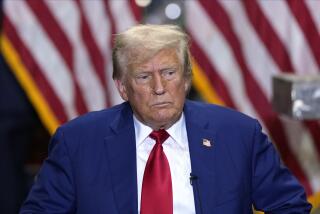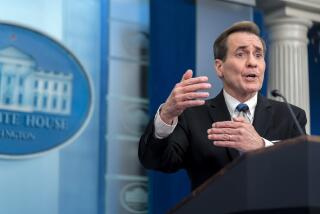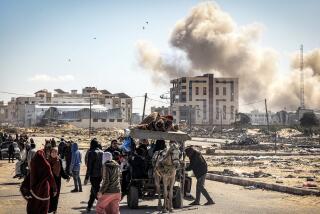Skeptics doubt U.S. can be certain about Iran’s nuclear progress
Reporting from Washington — Despite President Obama’s assurances that the United States will know if Tehran begins to secretly build a nuclear bomb, some senior officials familiar with U.S. intelligence and spying capabilities in Iran are doubtful.
The issue is a crucial one because the White House has suggested that U.S. satellites, sensors and spies, as well as United Nations inspections, provide a reliable tripwire to decide whether diplomacy has failed and military action is needed to stop Iran from assembling a nuclear device.
The officials’ doubts stem, in part, from Iran’s record of deceit.
Over the last decade, Western intelligence agencies have twice discovered large-scale clandestine Iranian facilities built to enrich uranium. The question now is whether Iran is hiding other nuclear enrichment sites or weapons research centers.
“You have to assume that, if they went clandestine once, they could well go clandestine in other places,” said Sen. Dianne Feinstein (D-Calif.), who chairs the Senate Intelligence Committee.
“As someone who deals with this stuff every day, I’m not sure how [the president] is that confident,” said Rep. Mike Rogers of Michigan, the top Republican on the House Intelligence Committee. “I am confident that at some point … we would know, probably. The problem is, you wouldn’t know if that meant they’d have a weapon in three days or in three months.”
Iran must produce weapons-grade uranium if it wants to build a bomb. For now, International Atomic Energy Agency inspectors make regular monitoring visits to the two uranium enrichment complexes, at Natanz and Fordow, and they measure and track every bit of nuclear material.
The U.N. inspectors would quickly detect diversion of uranium or any sudden push to boost enrichment from 20% to 90% to supply fuel for a weapon. If the teams are denied access or expelled from Iran, however, that safety mechanism disappears and Washington and its allies will be left to assume the worst.
“As long as the IAEA is inspecting the enrichment program, you’re going to get a heads up” if Iran tries to build a bomb, said Robert Kelley, a former senior IAEA inspector and nuclear expert at Los Alamos National Laboratory.
Iran’s relations with the IAEA are testy. Tehran has refused to fully answer questions about what the U.N. agency calls “possible military dimensions” to its program. It retreated on another issue last week, however, saying it would permit inspectors to visit a military base that it had previously put off-limits.
Iran announced in February 2010 that it would construct 10 new enrichment facilities. Iran’s nuclear chief said last August that the plan had been scrapped, but the IAEA’s most recent report points out that Iran has provided few details and cites its “lack of cooperation.”
Jeffrey Lewis, a nuclear expert at the Monterey Institute of International Studies, said he was reasonably confident Iran would get caught if it launched a covert enrichment effort. “But reasonably confident is not the same thing as certain,” he added.
A former senior U.S. intelligence official, who spoke on condition of anonymity, said Iran probably would move the clandestine project to multiple sites to lower the risk of discovery. “I think it would be very difficult” to learn if Iran began building a bomb, he said. “Not impossible, but difficult.”
Obama, in a recent interview with the Atlantic magazine, said the U.S. assessment is that Iran “does not have a nuclear weapon and is not yet in a position to obtain a nuclear weapon without us having a pretty long lead time in which we will know that they are making that attempt.”
Administration officials cite two reasons for his confidence.
“First, IAEA inspectors are on the ground safeguarding Iran’s enriched material and would detect any effort to divert it,” said a senior U.S. official, who asked for anonymity while discussing intelligence. “Secondly, we have detected covert facilities in the past … and are confident we would do so again before Iran is in a position to use such facilities to produce enriched uranium.”
Mark Fitzpatrick, a nonproliferation expert at the International Institute for Strategic Studies in London, has a similar view. If the Iranians “tempt fate by a decision to produce weapons,” they would probably use covert facilities, he said. “But would they be able to do it out of eyesight of prying intelligence agencies? Probably not.”
Olli Heinonen, a former deputy director general of the IAEA, said Iran may lack the precision engineering capabilities needed to build a working bomb. In theory, however, Iran could secretly construct a bomb or warhead, a process likely to take several years, and then produce weapons-grade fuel in a month or so.
“You can build everything else, but you just leave the nuclear material out and do that at the end,” said Heinonen, now a senior fellow at the Belfer Center for Science and International Affairs at Harvard University.
Others warn that spy satellites, surveillance drones and other sources may not be sufficient to spot a secret bomb program given Iran’s sprawling geography — one fifth the size of the continental U.S. — and large industrial base.
“Iran is a big country, and the idea that you can have blanket coverage — you can’t,” said Mark Lowenthal, a former senior CIA and State Department intelligence analyst.
Still, U.S. spy services and their allies have a substantial espionage effort aimed at Iran.
Analysts study business and procurement orders by Iranian companies, eavesdrop on government communications and monitor large construction and mining projects. Airborne sensors help analyze electromagnetic, chemical and other emissions that can offer telltale clues of what’s happening inside factories.
On the other hand, U.S. intelligence agencies were unaware that Syria was secretly constructing a nuclear reactor until shortly before Israeli warplanes destroyed the partially built facility in 2007, Rep. Rogers said.
The Iranians “are learning from their mistakes, and they are getting better about how to keep things more quiet,” he said. “This is a cat-and-mouse game for them.”
More to Read
Sign up for Essential California
The most important California stories and recommendations in your inbox every morning.
You may occasionally receive promotional content from the Los Angeles Times.











